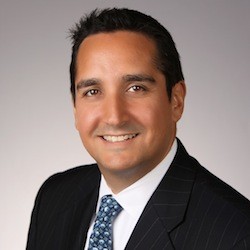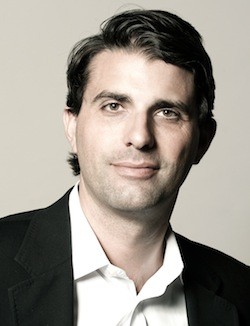Institutional investors’ adoption of options strategies continues, albeit slowly; can low bond yields be a tipping point?
Options continue to gain appeal in the eyes of institutional investors.
Usage of options at Pyramis Global Advisors “is definitely trending higher,” said Young Chin, chief investment officer at the $188 billion asset manager. “It’s an important area in how it provides a low-cost way to manage risk.”
It has been a long road in gaining a foothold in the rarefied air of large institutions, which are traditionally known for conservativism in their investment style. A perception pothole was hit in the financial crisis of 2008-2009, when many market observers blamed the catch-all asset class “risky derivatives” for touching off market mayhem.
But rather than try to prove a negative and assert that options don’t add risk, the Options Industry Council has taken a sort of ju-jitsu approach in its outreach, i.e. using the other side’s force and will to its advantage. Working on the premise that institutional investors want risk management, the trade group emphasizes that options provide risk management — so the net result of a properly executed options strategy is reduced risk.
“OIC only teaches and educates on options as a risk-reducing and income-generating tool,” said Alan Grigoletto, vice president of education at Chicago-based OIC. “It has strong appeal to a conservative portfolio manager.”

Alan Grigoletto, vice president of education at OIC
For options exchanges and trade handlers, pensions and other large institutional investors are the most coveted end-user demographic. It’s great to bring in new retail traders and wealth advisors, but at perhaps a few million dollars per account, it takes a lot to move the needle; for an institution with 11 or 12 figures under management, even a very small percentage approved for hedging via options results in meaningful order flow.
“OIC only teaches and educates on options as a risk-reducing and income-generating tool.”
Institutions Dabble
Many institutions are eyeing options or wading in to trading the securities, but in many cases the indicated comfort level still exceeds actual usage.
“We use options on a couple different fronts, but not to a major extent,” Chin told Markets Media. “For example, there may be certain equity positions that we’d like to have but in the near term we see some potential turbulence, so we might use derivatives to reduce exposure temporarily without necessarily selling out of that position. We also use derivatives in some of our hedging strategies with respect to absolute returns, for example we might use derivatives to enable short positions.”
“We are looking at exploring opportunities to have more products that are based on options, but that’s an area we’re developing and still yet to grow in terms of focus and emphasis,” Chin continued. “I know other firms might use derivatives in an alpha-seeking or risk-taking mode; we haven’t done much on that front yet.”
Data on institutional options usage is limited, as the securities are typically traded as part of an equity portfolio and not their own reportable asset class with a percentage allocation, like alternative investments for example. U.S. public-pension chief investment officers who have recently discussed their use of options include Tim Walsh of the New Jersey Division of Investment and John Colville of the City of Sacramento pension plan.
In Canada, where institutional investors are generally more inclined to trade derivatives, Healthcare of Ontario Pension Plan use options on offense, or alpha generation, as well as defense, or risk management. “We run a separate return-seeking portfolio to generate incremental returns around option volatility, as well as other absolute-return strategies,” said Jim Keohane, chief executive of Toronto-based HOOPP. “Our long-term option strategy, in which equity-index exposure is combined with equity-index options, is a major contributor to the return-seeking portfolio.”
Keohane has said HOOPP deploys derivatives to bridge the gap between fixed-income yields, which are at historically low levels, and the annual return the plan needs to keep pace with its liabilities, or obligations to its plan members. With rock-bottom bond yields expected to persist at least for the short to medium term, and pension plans moving very slowly to notch down return hurdles, the OIC views options as part of the solution to the conundrum.
Yield on the benchmark 10-year U.S. Treasury note has contracted to less than 2%, near historical lows and a massive come-down from the 4% to 6% level that was the norm years ago. The absolute value isn’t necessarily the problem, rather it’s the yawning gap between what pensions can earn from bonds and their liabilities. “Everybody needs yield,” Grigoletto said.
An investor holding a stock but with a neutral short-term view can derive income from a covered call. If the stock holds steady or declines, the investor keeps the proceeds from the covered call; however, this limits the upside of the position, as the stock will be called if the stock reaches the strike price. An investor with a bearish view of an underlying holding can buy put options and generate income if the stock declines below the strike price.
“What is appealing about options is that when employed in a systematic covered-call writing or put-buying methodology, you can not only mitigate some — not all — of the downside risk, but also enhance yield,” Grigoletto explained. “The strategy can act as a substitute for a portion of fixed-income allocation. This is how we’re getting the attention of pensions, endowments, and even wealth advisers to move toward options…We are seeing a slow adoption and we have heard several success stories where option income has helped to add significant yield while lowering risk.”
Sell-side facilitators of options trades report increased usage among buy-side investors, more so with firms that are inclined to trade more actively.
New-Client Variety
“We see demand from the buy side for trading options electronically — over the past several years, we have seen continued growth with the onboarding of new clients,” said Pat Luongo, head of options at Credit Suisse’s Advanced Execution Services unit. “In addition to clients who trade equities and sometimes even futures, we’re also seeing new market participants, for example people who trade volatility.”

Pat Luongo, head of options at Credit Suisse’s Advanced Execution Services unit
“In addition to clients who trade equities and sometimes even futures, we’re also seeing new market participants, for example people who trade volatility.”
Luongo noted that high option volume in the second half of 2011 gave way to less trading overall in 2012, though AES saw an uptick in volume, revenue and market share. “Now we’re back in a low-volatility environment and we seem to be a sticky solution for clients when it comes to providing the algo, smart order routing tools and advanced single-leg tactics,” Luongo said. “We’ve also seen a big uptick in spread trading.”
Not surprisingly, Luongo said hedge funds are generally more comfortable trading options electronically than are pension funds, which tend to tap the sell side for the high-touch capabilities provided by a desk trader on the other end of the phone. However this is at least partly a function of the underlying product of choice, rather than a lack of market-structure savvy.
“A lot of pensions trade index products like SPX (S&P 500) or something more exotic than just single-stock or ETF options, and generally, since SPX is still a pit-driven market, clients can sometimes have better success getting more liquidity through our high-touch desk versus electronically,” Luongo said. “Hedge funds are more inclined to trade single-stock, ETFs and some index options electronically — we see a growing number of hedge funds seeing liquidity on the screen and going out and grabbing it.”
Luongo estimated 25% to 40% of AES’ options order flow comes from complex order books, which enable electronic trading of multipart-strategy, or spread, orders. A spread position is entered by buying and selling equal number of options of the same class on the same underlying security but with different strike prices or expiration dates.
Trading via a complex order books can eliminate leg risk, or the risk that price movements between individual-order executions will undermine a trade plan.
“Most clients don’t want leg risk so they put orders in as packages,” Luongo said. “We educate clients on what happens when they enter an order, and we utilize multiple complex order books to try to increase fulfillment ratios. We don’t go to every complex order book, but we go to all of the big ones. Our clients are comfortable with it, and they’re getting good fill ratios and nice-sized trades with multiple legs.
Weekly options haven’t been adopted by all options users, but Luongo said the product has proven sticky with the buy-side firms that have picked up on it. “Initially, people didn’t know how to utilize them, since they were viewed as speculative or very short-term,” he said. “However, now we see clients better incorporating them into their strategies and using them to hedge further-out positions.”
The emergence of weekly options shows “the traditional (monthly) expiration is becoming much less important,” said Stephen Solaka, founding partner at Los Angeles-based Belmont Capital Group, which manages money for family offices, wealth advisory firms, and institutions. “Especially on the index side, you’re seeing expiration every week. That’s allowing people to be more specific, whether they’re looking for a catalyst on the equity side or playing more macro events.”

Stephen Solaka, founding partner at Belmont Capital Group
More broadly, “options allow you to shape traditional return streams,” Solaka told Markets Media. “Whether that means risk management or alpha capture, it just allows you to better define your outcomes, knowing specific points where you can buy or sell stock or enter positions via options.”
“Options allow you to shape traditional return streams.Whether that means risk management or alpha capture, it just allows you to better define your outcomes.”
Tight Spreads
From a liquidity perspective, Solaka said that while the market-making business is squeezed, trading friction is generally low for institutional options players. “There has never been a better time to be on the buy side and be a market taker,” he said. “A lot of the liquidity has moved off the floor, but it’s a great time. Spreads are tight and it’s very liquid due to the role hedge funds and other buy side are playing in the markets.”
“The buy side will continue to get bigger” in options, Solaka said. “Institutionally, you’ve only seen the tip of the iceberg…There will be more customized stuff on the institutional side, whether managing risk or funding levels, but it takes time. It’s a very big ship and it’s not easy to turn.”
Better computer power and risk modeling should make more institutions comfortable with the idea of trading options, according to KOR Trading Founder and President Chris Nagy.
“Computing power has become extremely inexpensive compared with just seven to ten years ago — it’s unbelievable what you can do,” Nagy said. “The benefit of that is with better computing power comes better risk models in the marketplace. And when buy-side institutional firms have better ability to measure and quantify risk, I think there’s a big opportunity to engage them in the options markets and products, where historically you haven’t had a lot of those risk measurements available.”
A potential draw for institutional investors with long-term investment horizons is a Chicago Board Options Exchange proposal to extend some options expirations to as long as 15 years. For an institution with little interest in hedging or speculation on a weekly or monthly basis, a closer alignment with holding periods may be appealing.
There are questions regarding liquidity and the viability of making markets for long-term options, but if implemented effectively such a product “could help pave the way for more institutional investors,” Nagy said.
While there are disagreements among market participants with regard to which specific products will bring in more institutional options users, there is a consensus that education needs to be at the forefront of outreach efforts. A buy-side manager who’s aware of options but not well-versed in how to use them isn’t likely to get more involved in the market, but a manager who just learned how options can help achieve portfolio goals might be.
“For many institutional customers, especially traditional long-only accounts, there is clearly a growing interest in being more educated on the options product,” said Kevin Murphy, head of U.S. options electronic execution at Citigroup. “We have heard from many institutions that say they plan to trade more options in the future, and are hiring options personnel.”
“Risk management plus alpha generation is a very important combination, as just being ‘naked long’ doesn’t really work anymore,” Murphy continued. “More equity players are realizing that they need to have a little diversity in their investment style. Meanwhile, a more educated options user is actually better for the options industry, because it’s not a zero-sum game. As customers start getting smarter in their option strategies, market makers will have more flow to trade with. So the more people understand the product, the stronger the product gets.”
Said Grigoletto, “we don’t have any doubts here at OIC that we’re on the right track as far as bringing this knowledge to pension funds. We think we provide a very good solution when matched against the alternative of fixed income as it stands today.”
“You’ll often see people who are searching for yield move out of vanilla T-bills and 30-year bonds, go out on the risk frontier and chase high yield. They’re taking on considerable risk,” Grigoletto said.
“The tactic that we have is to say options are not risky, and if you’re in the high yield junk-bond market, you’re already beyond the risk profile of options.”
Still, it’s a very gradual process. “Nobody is going to jump in with both feet and write covered calls on every single stock,” Grigoletto said. “It’s baby steps.”
